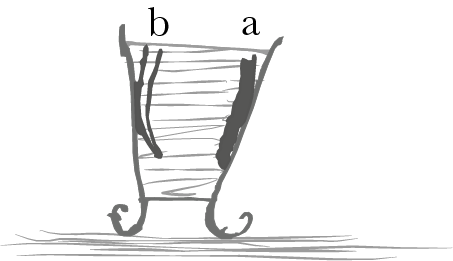From Francis Darwin [before 26 June 1879]1
Bot Institut | Würzburg
My dear Father,
Never mind about Rhagadiolus & Hieracium, I am sorry I bothered you, as I have managed to get some seeds here.2 I did the caustic experiment with Faba & Phaseolus in damp earth & by evening they had all grown well & the caustic ones had not bent, but next morning many of the caustic ones were bent—so Sachs doesn’t believe in it a bit;3 he says the growth is disturbed and that anything that disturbs growth prevents geotropism— as for instance merely growing in damp air in some cases. He also says caustic is not a proper thing for the work because nitric acid will be set free & this will be diffused back into the root & injure it!!!!4 It is certain that the true growing cells of the root itself under the root-cap are killed (Göbel5 looked at the caustic sections & said so) but one could not cause so slight an injury with a razor, which Sachs thinks would be better, because even if you could confine your slice to the cells so near the surface the water in which the roots would be put to grow in would cause a deeper injury: but with caustic you injure the surface & the injury spreads only a little way in. Sachs doesn’t believe that in the shellac experiment it is the touching of the little bit of shellacced-glass that makes the root bend, because he says in his experiments
 with vessels with sloping walls the root grows down as (a) whereas if the touching had any effect it ought to go as b— Of couse the thing is that the bending ceases directly the root has bent away. I said you had done experiments with smoked glass and that the roots grew down sloping surfaces not by pressing hard against them, but only touching in a number of places or at least touching very lightly.6 Then he said that the smoke may cause injury to the root! one feels inclined to say— If you say that its no use talking with you. I thought you had observed that a root growing down a clean glass slide seemed to go along without touching the glass, but I wasn’t sure enough to say so.
with vessels with sloping walls the root grows down as (a) whereas if the touching had any effect it ought to go as b— Of couse the thing is that the bending ceases directly the root has bent away. I said you had done experiments with smoked glass and that the roots grew down sloping surfaces not by pressing hard against them, but only touching in a number of places or at least touching very lightly.6 Then he said that the smoke may cause injury to the root! one feels inclined to say— If you say that its no use talking with you. I thought you had observed that a root growing down a clean glass slide seemed to go along without touching the glass, but I wasn’t sure enough to say so.
I have started some heliotropic caustic experiments but: the roots even without caustic bend so badly in these pitch dark green houses that it is no good I am afraid. I have today started another in better light. I did one pot of mustard roots but alas the caustic ones were apheliotropic. The mustard roots are extraordinarily sensitive. I put some in the middle of this big laboratory in a black box whose opening was covered with thickish writing paper & put it facing the N on a cloudy day & they were clearly bent from light: the cotyledon had not light enough to be properly green
My great difficulty is making the marks. I do it with aspalt varnish. & put the roots on wet blotting paper under a bell for a few minutes while the varnish dries, but this amount of drying seems to hurt the roots, as some do not grow or hardly so,— (but these are only 2 or 3 out of 20 or 30): sometimes I can get the varnish so dry that I can pop the roots strt into water & then they grow much better. If I can get a bit of clockwork put to rights I shall measure them with a telescope like Vines did.7 I shan’t bother about Rhizomorpha as the seedling roots will decide the question.8
My love to Mother I will write a decent letter next time | Your affec F.D.
CD annotations
Footnotes
Bibliography
Movement in plants: The power of movement in plants. By Charles Darwin. Assisted by Francis Darwin. London: John Murray. 1880.
Sachs, Julius. 1872a. Ablenkung der Wurzeln von ihrer normalen Wachsthumsrichtung durch feuchte Körper. Arbeiten des Botanischen Instituts in Würzburg 1 (1871–4): 209–22.
Sachs, Julius. 1873–4. Ueber das Wachsthum der Haupt- und Nebenwurzeln. Arbeiten des Botanischen Instituts in Würzburg 1 (1871–4): 385–474, 584–634.
Vines, Sydney Howard. 1878. The influence of light upon the growth of unicellular organs. Arbeiten des botanischen Instituts in Würzburg 2 (1878–82): 133–47.
Summary
Discusses results of geotropism experiment. Has started some heliotropic caustic experiments on mustard roots. Has trouble making marks.
Letter details
- Letter no.
- DCP-LETT-12126F
- From
- Francis Darwin
- To
- Charles Robert Darwin
- Sent from
- Würzburg
- Source of text
- DAR 274.1: 55
- Physical description
- ALS
Please cite as
Darwin Correspondence Project, “Letter no. 12126F,” accessed on 23 April 2024, https://www.darwinproject.ac.uk/letter/?docId=letters/DCP-LETT-12126F.xml


